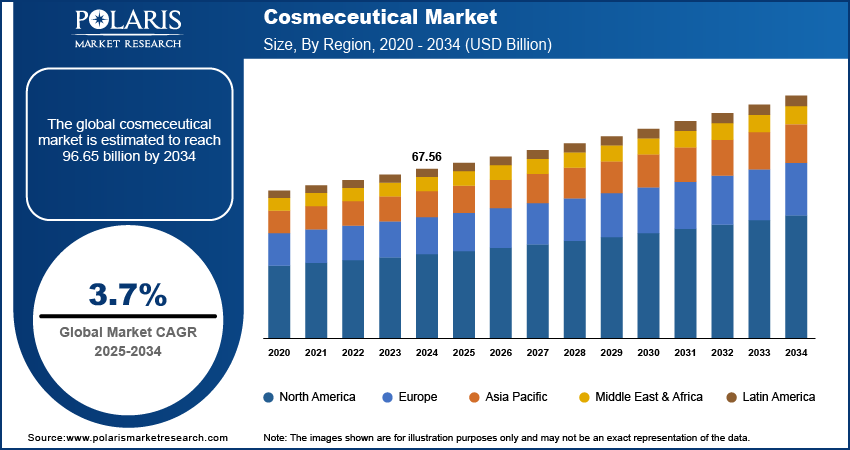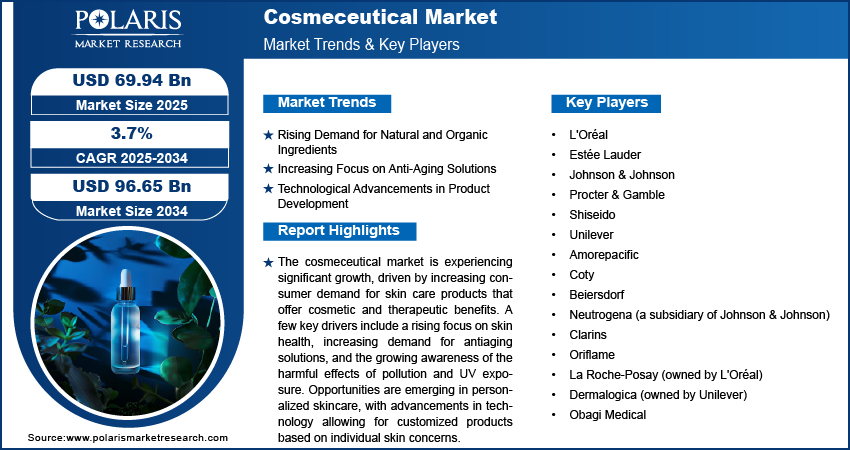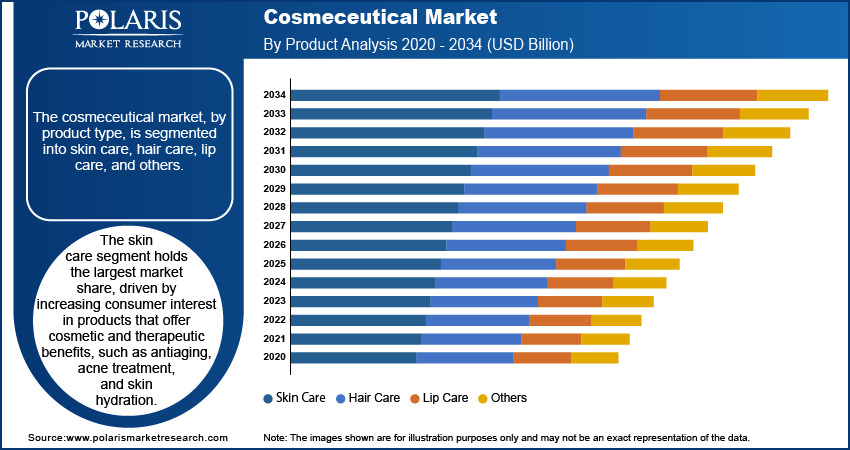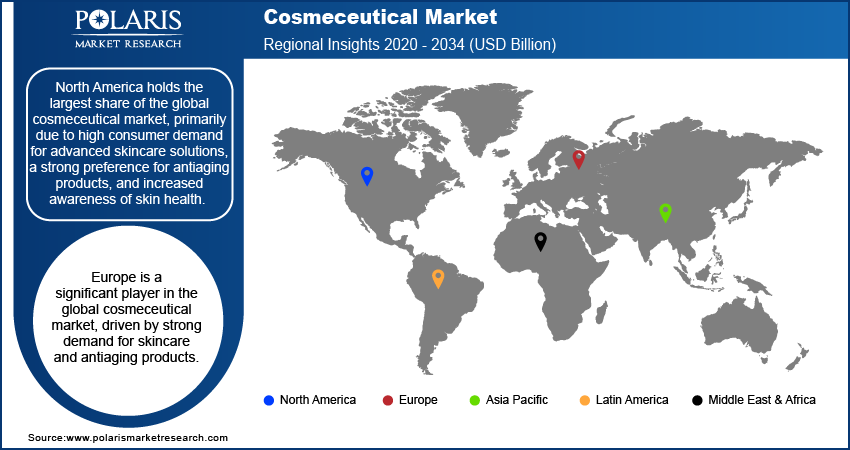
Cosmeceutical Market Size, Share, Trends, Industry Analysis Report
: By Product Type (Skin Care, Hair Care, Lip Care, and Others), Distribution Channel, and Region (North America, Europe, Asia Pacific, Latin America, and Middle East & Africa) – Market Forecast, 2025–2034
- Published Date:Dec-2024
- Pages: 118
- Format: PDF
- Report ID: PM1636
- Base Year: 2024
- Historical Data: 2020-2023
Cosmeceutical Market Overview
The global cosmeceutical market size was valued at USD 67.56 billion in 2024. The market is projected to grow from USD 69.94 billion in 2025 to USD 96.65 billion by 2034, exhibiting a CAGR of 3.7% during 2025–2034.
The global cosmeceutical market refers to the segment of skincare and beauty products. The market focuses on products that combine cosmetic and pharmaceutical properties, offering both aesthetic benefits and therapeutic effects. Rising consumer demand for products that promote skin health, anti-aging benefits, and overall wellness propels the cosmeceutical market expansion. Key drivers include the increasing focus on personal grooming; rising skin-related concerns such as acne and pigmentation; and growing awareness of the benefits of active ingredients such as peptides, antioxidants, and hyaluronic acid. Cosmeceutical market trends are the shift toward natural and organic ingredients, the increasing popularity of anti-aging solutions, and advancements in research and development that lead to more effective and targeted products.

To Understand More About this Research: Request a Free Sample Report
Cosmeceutical Market Dynamics
Rising Demand for Natural and Organic Ingredients
Consumers are increasingly seeking cosmeceutical products formulated with natural and organic ingredients, driven by growing concerns over the safety and environmental impact of synthetic chemicals. This trend has been particularly prominent as consumers become more knowledgeable about the ingredients in their skincare products and their effects on health. Natural skincare solutions, such as plant-based extracts, essential oils, and herbal formulations, are seen as gentler on the skin and more sustainable. According to a 2022 survey by Statista, 42% of consumers globally prefer products that are made with organic ingredients. As a result, brands are incorporating eco-friendly and clean-label ingredients into their formulations to meet this demand. This trend is further supported by the increasing availability of certifications such as "organic" and "natural" on product labels, which reassure consumers about the authenticity of these claims. Thus, the increasing demand for natural and organic ingredients is expected to emerge as a key cosmeceutical market trend during the forecast period.
Increasing Focus on Anti-Aging Solutions
Consumers seek antiaging products that target signs of aging, such as fine lines, wrinkles, and loss of skin elasticity. The demand for anti-aging products is largely driven by an aging global population and the growing awareness of skin health and wellness. Active ingredients such as retinol, peptides, and antioxidants, which have demonstrated efficacy in slowing the visible effects of aging, are becoming increasingly common in these formulations. Additionally, the influence of social media, where influencers and skincare experts regularly promote anti-aging products, has fueled this trend, particularly among younger demographics eager to prevent premature aging. Therefore, the increasing popularity of antiaging solutions would drive the cosmeceutical market demand in the coming years.
Technological Advancements in Product Development
Technological advancements in cosmeceutical product development make them more effective and tailored to individual skin needs. Research and innovation in biotechnology, nanotechnology, and dermal delivery systems are enhancing the performance and penetration of active ingredients in cosmeceuticals. For instance, the use of nanotechnology allows for more efficient delivery of ingredients, ensuring deeper absorption into the skin for improved results. Moreover, biotechnology has led to the creation of bio-identical ingredients, which mimic the body's natural processes for better compatibility and effectiveness. According to a report by the International Journal of Cosmetic Science, the global cosmeceuticals industry is expected to benefit from these innovations as they improve the targeted treatment of skin concerns and drive new product launches. As these technologies become more accessible, companies are leveraging them to offer personalized skincare solutions that cater to various skin types and concerns. Thus, the rising technological advancements in the development of cosmeceutical products are projected to drive the cosmeceutical market growth during 2025–2034.

Cosmeceutical Market Segment Insights
Cosmeceutical Market Outlook – by Product Type-Based Insights
The cosmeceuticals market, by product type, is segmented into skin care, hair care, lip care, and others. The skin care segment holds the largest market share, driven by increasing consumer interest in products that offer cosmetic and therapeutic benefits, such as antiaging, acne treatment, and skin hydration. With the rise in skin-related concerns, including pigmentation, wrinkles, and environmental damage, demand for cosmeceutical products in this category continues to expand. Active ingredients such as peptides, retinoids, and antioxidants are commonly used in these products, which have gained significant consumer trust due to their proven efficacy. As consumers become more focused on personalized skincare solutions, the skin care segment is witnessing a surge in demand for targeted treatments and products designed for specific skin types and conditions, such as sensitive skin or acne-prone skin.
The hair care segment is registering the highest growth rate in the cosmeceutical market, fueled by the increasing prevalence of hair loss, dandruff, and scalp-related issues. As consumers seek solutions for promoting hair health and preventing hair thinning, products containing bioactive ingredients such as biotin, keratin, and plant-based extracts are becoming popular. This growth is particularly evident among younger consumers who are looking for preventative measures, as well as aging populations seeking to combat thinning hair. Additionally, advancements in formulations, such as scalp treatments and hair growth serums, have driven innovation in the segment, further contributing to its expansion. The rising demand for multifunctional hair care products that improve hair quality and nourish the scalp is expected to drive the growth of this segment in the coming years.
Cosmeceutical Market Evaluation – by Distribution Channel-Based Insights
The cosmeceuticals market, by distribution channel, is segmented into supermarkets & specialty stores, online platforms, and other offline platforms. The online platform segment holds the largest share of the global cosmeceutical market revenue, driven by the growing preference for e-commerce shopping and the increasing convenience of purchasing beauty products online. Consumers are increasingly turning to digital platforms to access a wide variety of cosmeceutical products, where they can easily compare prices, read customer reviews, and access exclusive deals. The expansion of online retailers such as Amazon, specialized e-beauty stores, and direct-to-consumer brand websites has further facilitated this shift. Additionally, the use of digital marketing and social media influence by cosmeceutical brands has significantly influenced purchasing behavior, as consumers increasingly rely on online content for product recommendations and skincare routines.
The supermarkets and specialty stores segment continues to be a significant distribution channel, but it is registering slower growth than the online platforms segment. However, these traditional retail outlets remain popular for consumers who prefer to shop in person and directly experience the product before making a purchase. In particular, specialty stores with a focus on skincare and beauty products provide an experiential shopping environment, offering knowledgeable staff and the opportunity to test products. Despite the rise of online shopping, many consumers still value the convenience and immediate availability of products from supermarkets and physical retail stores. The steady presence of these stores in the market ensures that they maintain a stable share, though the online platform segment is rapidly overtaking them in terms of growth.

Cosmeceutical Market Regional Insights
By region, the study provides cosmeceuticals market insights into North America, Europe, Asia Pacific, Latin America, and the Middle East & Africa. North America holds the largest share of the global cosmeceutical market revenue. High consumer demand for advanced skincare solutions, a strong preference for antiaging products, and increased awareness of skin health boost the regional market growth. The region benefits from a well-established beauty & wellness industry, with a significant presence of established and emerging cosmeceutical brands. The US, in particular, leads the North America cosmeceuticals market share, driven by a large, diverse consumer base and a growing trend toward personalized skincare solutions. Factors such as high disposable income, strong retail infrastructure, and a robust e-commerce sector further support North America's dominance. Additionally, the growing focus on product efficacy and ingredient transparency among consumers continues to propel market growth in this region.
Europe is a significant player in the global cosmeceutical market, driven by a strong demand for skincare and antiaging products. The market is characterized by a growing preference for natural and organic ingredients, as European consumers are highly concerned about product safety and environmental sustainability. Countries such as Germany, France, and the UK are at the forefront of this trend, with established beauty standards and a well-developed retail network. Additionally, European consumers tend to be more focused on the efficacy of cosmeceuticals, leading to a preference for clinically tested and dermatologist-approved products. The rise of clean beauty and eco-conscious packaging further supports the market growth in Europe, positioning it as a leading region in the adoption of innovative cosmeceutical solutions.
The Asia Pacific cosmeceutical market is experiencing rapid growth, with increasing demand driven by the rising middle-class population, higher disposable income, and growing beauty consciousness, particularly in countries such as China, Japan, South Korea, and India. South Korea is a key hub for skincare innovations, with the K-beauty trend influencing global cosmeceutical preferences, especially for antiaging and brightening products. Additionally, the increasing focus on skin health and wellness in emerging markets such as India and China has led to a surge in demand for cosmeceuticals that address skin issues such as acne, pigmentation, and wrinkles. The expansion of online retail platforms and the rising adoption of social media-driven beauty trends are also fueling growth in this region, making Asia-Pacific one of the fastest-growing markets for cosmeceuticals.

Cosmeceutical Market – Key Players and Competitive Insights
L'Oréal, Estée Lauder, Johnson & Johnson, Procter & Gamble, and Shiseido are among the key players in the cosmeceutical market. The players have strong product portfolios across skincare, hair care, and other beauty categories. Other notable companies include Unilever, Amorepacific, Coty, and Beiersdorf, known for their innovative skincare solutions that combine cosmetic and pharmaceutical benefits. Companies such as Neutrogena (a subsidiary of Johnson & Johnson), Clarins, and Oriflame also play an active role in the market, offering products with targeted benefits such as antiaging, skin hydration, and pigmentation treatments. Additionally, brands such as La Roche-Posay (owned by L'Oréal) and Dermalogica (owned by Unilever) continue to expand their cosmeceutical offerings to meet the increasing demand for effective skin health products. The market also features niche players such as Obagi Medical, PCA Skin, and Jan Marini Skin Research, which specialize in more specific and clinical skincare solutions.
The competitive landscape in the cosmeceutical market is shaped by companies that emphasize research and development to create products with clinically proven efficacy. Many of these players invest heavily in developing active ingredients that address common skincare concerns such as acne, aging, and skin inflammation. The larger companies benefit from their extensive distribution networks and established brand recognition, while smaller, more specialized companies focus on niche markets with highly targeted formulations. For instance, brands such as La Roche-Posay and Neutrogena often rely on dermatological endorsements, giving them credibility in the medical skincare space. At the same time, companies such as Shiseido and Amorepacific have capitalized on trends such as K-beauty, which has gained significant traction in global markets, especially in Asia Pacific.
In terms of competitive insights, companies in the cosmeceutical market are increasingly prioritizing personalization and digital channels to cater to the growing demand for individualized skincare solutions. The use of artificial intelligence and machine learning to analyze customer preferences and recommend customized products is becoming common. Additionally, a significant trend is the rising focus on sustainability and eco-friendly packaging, with many players working toward cleaner, more sustainable formulations. To stay competitive, companies are also forming strategic partnerships, conducting clinical trials, and leveraging influencers and social media platforms to drive brand engagement and consumer loyalty. While larger firms dominate the market share, smaller companies are thriving by offering specialized products and engaging in direct-to-consumer marketing strategies.
L'Oréal is one of the most recognized names in the cosmeceutical market, with a wide range of skincare, hair care, and beauty products. The company has invested heavily in research to develop effective skincare solutions, with a focus on dermatologically tested products. L'Oréal's portfolio includes well-known brands such as La Roche-Posay, Vichy, and Garnier, which offer cosmeceuticals addressing various skin concerns, including aging and sensitive skin. The company is also making strides in sustainability, with efforts to reduce its environmental impact through eco-friendly packaging and ethical sourcing.
Johnson & Johnson, through its diverse product range, plays an important role in the cosmeceutical market, particularly with its skincare offerings under brands such as Neutrogena and Aveeno. The company focuses on offering solutions for skin health, from treating acne to addressing signs of aging. J&J is committed to advancing skin care through extensive clinical research, providing products that are effective and widely available.
Key Companies in Cosmeceutical Market
- L'Oréal
- Estée Lauder
- Johnson & Johnson
- Procter & Gamble
- Shiseido
- Unilever
- Amorepacific
- Coty
- Beiersdorf
- Neutrogena (a subsidiary of Johnson & Johnson)
- Clarins
- Oriflame
- La Roche-Posay (owned by L'Oréal)
- Dermalogica (owned by Unilever)
- Obagi Medical
Cosmeceutical Industry Developments
- In February 2024, Johnson & Johnson announced the launch of a new line of skincare products under its Neutrogena brand, which utilizes innovative dermatological technology to enhance skin hydration and support long-term skin health. The brand's emphasis on innovation continues to strengthen its position in the cosmeceutical market.
- In October 2023, L'Oréal announced its acquisition of the skincare brand "Aesop" from Natura &Co, a move that strengthens its position in the premium beauty and skincare segment.
Cosmeceutical Market Segmentation
By Product Type Outlook
- Skin Care
- Hair Care
- Lip Care
- Others
By Distribution Channel Outlook
- Supermarkets & Specialty Stores
- Online Platform
- Other Offline Platforms
By Regional Outlook
- North America
- US
- Canada
- Europe
- Germany
- France
- UK
- Italy
- Spain
- Netherlands
- Russia
- Rest of Europe
- Asia Pacific
- China
- Japan
- India
- Malaysia
- South Korea
- Indonesia
- Australia
- Vietnam
- Rest of Asia Pacific
- Middle East & Africa
- Saudi Arabia
- UAE
- Israel
- South Africa
- Rest of Middle East & Africa
- Latin America
- Mexico
- Brazil
- Argentina
- Rest of Latin America
Cosmeceutical Market Report Scope
|
Report Attributes |
Details |
|
Market Size Value in 2024 |
USD 67.56 billion |
|
Market Size Value in 2025 |
USD 69.94 billion |
|
Revenue Forecast by 2034 |
USD 96.65 billion |
|
CAGR |
3.7% from 2025 to 2034 |
|
Base Year |
2024 |
|
Historical Data |
2020–2023 |
|
Forecast Period |
2025–2034 |
|
Quantitative Units |
Revenue in USD billion and CAGR from 2025 to 2034 |
|
Report Coverage |
Revenue Forecast, Market Competitive Landscape, Growth Factors, and Trends |
|
Segments Covered |
|
|
Regional Scope |
|
|
Competitive Landscape |
|
|
Report Format |
|
|
Customization |
Report customization as per your requirements with respect to countries, regions, and segmentation. |
FAQ's
The global cosmeceutical market size was valued at USD 67.56 billion in 2024 and is projected to grow to USD 96.65 billion by 2034
The global market is projected to register a CAGR of 3.7% during 2025–2034.
North America held the largest share of the global market in 2024.
A few of the key cosmeceutical market players are L'Oréal, Estée Lauder, Johnson & Johnson, Procter & Gamble, and Shiseido, which have strong product portfolios across skincare, hair care, and other beauty categories.
The skin care segment dominated the global cosmeceutical market share in 2024.
The online segment accounted for the largest share of the global market in 2024.
A cosmeceutical is a type of cosmetic product that combines both cosmetic and pharmaceutical properties. The products offer benefits beyond basic aesthetic enhancement. They are designed to improve the health and appearance of the skin by incorporating active ingredients that have therapeutic effects. Unlike regular cosmetics, which mainly focus on enhancing appearance, cosmeceuticals aim to address specific skin concerns, such as acne, wrinkles, pigmentation, and inflammation, through scientifically backed formulations. The active ingredients in cosmeceuticals, such as antioxidants, peptides, retinoids, and hyaluronic acid, often target deeper layers of the skin for more effective, long-lasting results.
A few key trends in the cosmeceutical market are described below: ? Increased Demand for Natural and Organic Ingredients: Consumers are seeking products with clean, sustainable, and eco-friendly formulations that avoid synthetic chemicals. ? Rising Popularity of Antiaging Products: There is a growing focus on products targeting signs of aging, such as fine lines, wrinkles, and skin elasticity, with active ingredients such as peptides and retinoids. ? Surging Focus on Personalized Skincare: Advancements in technology and data analysis allow brands to offer customized skincare solutions tailored to individual needs and skin types. ? Growing Adoption of E-Commerce Platforms: Online platforms continue to grow as key distribution channels, offering consumers easy access to a wide range of cosmeceutical products.
A new company entering the cosmeceutical market must focus on product innovation and personalized skincare to stand out. Leveraging advancements in technology, such as AI for creating tailored skincare regimens, can help meet the growing demand for individualized solutions. Additionally, prioritizing natural and sustainable ingredients, along with eco-friendly packaging, aligns with consumer preferences for clean and environmentally responsible products. The company could also capitalize on e-commerce platforms, utilizing social media and influencer partnerships to reach a broader audience. Finally, ensuring clinical validation of products through dermatological endorsements can enhance trust and credibility in the competitive market.
Companies manufacturing, distributing, or purchasing cosmeceutical and related products and other consulting firms must buy the report.
